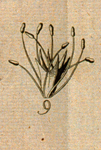
Linnaeus synthesized botanical efforts that accumulated through history and around the globe. His work stabilized botany as a discipline, making it logical, available to scholars around the world, and eventually accessible to a broad group of lay people. Foreigners flocked to Uppsala to study with Linnaeus, and his students included Falck, Kalm, Löfling, Forskål, Solander, Sparrman, Thunberg, and Swartz. Linnaeus taught them logical systematics and sent them off into the world. The map on the next page shows the paths by which Linnaean nomenclature attempted to make sense of the world. His students furthered Europe’s knowledge of the world and increased non-European nations’ knowledge of themselves.
Johan Peter Falck (ca.1732–1774) incorporated binomials into the report of his Russian explorations, revealing that cloth could be dyed yellow with Iris siberica’s flowers and red with Galium spec. and that black currants and Actorus calamus had medicinal properties. Pehr Kalm diligently sent specimens from North America, with 90 of the 700 North American plants in Species Plantarum attributed to him. In Amsterdam Carl Peter Thunberg met with professors who were devotees of Linnaeus and who enabled his fruitful studies of South Africa, resulting in Prodromus Plantarum Capensium (Uppsala, 1794–1800) and Flora Capensis (Uppsala, 1807–1813).
But in addition to the work of his well-travelled and well-documented students, Linnaeus formed a lineage model of teaching botany that persists today; his students modeled their voyages on his and assumed scientific exploration would improve their homeland. Linnaeus’ provincial explorations made Sweden more knowable to its inhabitants; under Linnaeus’ guidance, botany became a national concern with its potential for exotic crop cultivation, transplantation, and import substitution. His garden’s pineapples, watermelons, apricots, and peaches and his attempts to grow cotton and tea changed plantsmen’s thinking on climate and naturalization.